List_of_presidents_of_Bolivia
The president of Bolivia is the head of state and head of government of Bolivia, directly elected to a five-year term by the Bolivian people. The officeholder leads the executive branch of the government and is the captain general of the Armed Forces of Bolivia.
Since the office was established in 1825, 65 men and 2 women have served as president. The first president, Simón Bolívar, was elected by the General Assembly of Deputies of the Province of Upper Peru. For purposes of numbering, members of jointly-ruling juntas and other governing bodies are not included in the official count of presidents, unless one member later assumed the presidency in their own right. Three presidents: Antonio José de Sucre, Germán Busch, and Hernán Siles Zuazo became, after a brief, non-consecutive, interim exercise of power, presidents for longer terms later. In these cases, they are numbered according to that second term. Therefore, Busch is counted as the 36th president, not the 35th, Siles Zuazo as the 46th instead of the 45th, etc.[1]
The presidency of Pedro Blanco Soto, who was assassinated six days after taking office in 1828, was the shortest in Bolivian history. Evo Morales served the longest, over thirteen years, before resigning in 2019. He is the only president to have served more than two consecutive terms. José Miguel de Velasco and Víctor Paz Estenssoro each served for four terms. However, all of Velasco's were non-consecutive and two were in an acting capacity while Paz Estenssoro only served twice consecutively in 1960 and 1964.
Three presidents died in office, one of natural causes and two through tragic circumstances (Adolfo Ballivián, Germán Busch, and René Barrientos). Three were assassinated (Pedro Blanco Soto, Agustín Morales, and Gualberto Villarroel). The latter resigned mere hours before his death. Additionally, Manuel Antonio Sánchez and Pedro José de Guerra died of natural causes while exercising provisional presidential functions while eight former presidents were assassinated after leaving office (Antonio José de Sucre, Eusebio Guilarte, Manuel Isidoro Belzu, Jorge Córdova, Mariano Melgarejo, Hilarión Daza, José Manuel Pando, and Juan José Torres).[2]
Five vice presidents assumed the presidency during a presidential term (José Luis Tejada Sorzano, Mamerto Urriolagoitía, Luis Adolfo Siles Salinas, Jorge Quiroga, and Carlos Mesa). Tejada Sorzano was the first to do so in 1934 while Quiroga was the only one to complete the term of their predecessor (Tejada Sorzano extended his mandate past the term of his predecessor).
22 presidents were deposed in 23 coups d'état (1839, 1841; twice, 1848; twice, 1857, 1861, 1864, 1871, 1876, 1879, 1920, 1936, 1937, 1943, 1964, 1969, 1970, 1971, 1978; twice, 1979, and 1980). Velasco was deposed twice in 1841 and December 1848. Additionally, the Council of Ministers of Hernando Siles Reyes was deposed in 1930. Three presidents were deposed by a civil war, a popular uprising, and a revolution. Transmissions of command from one de facto government to another de facto government occurred in seven cases (1841, 1946, 1965, 1966, 1981; twice, and 1982). Two special cases occurred in 1939 when Carlos Quintanilla was installed by the military after the death of Germán Busch and in 1951 when President Mamerto Urriolagoitía resigned in a self-coup in favor of a military junta. Two unconstitutional successions occurred in 1930 when Hernando Siles Reyes entrusted command to his council of ministers and 1934 when Daniel Salamanca was ousted in favor of his vice president, José Luis Tejada Sorzano.[3] Finally, some supporters of Evo Morales claim that he was ousted by a coup d'état and that the presidency of Jeanine Áñez was an unconstitutional succession of power. However, this is disputed.[4]
There are seven living former presidents. The most recent to die was Luis García Meza, on 29 April 2018.
| Heads of State of the State of Upper Peru, or Republic of Bolívar (1825–1826) | ||||||||||
|---|---|---|---|---|---|---|---|---|---|---|
| Presidency[lower-alpha 1] | President | Party | Designation | Government[lower-alpha 2] | Vice President | |||||
| From 6–11 August 1825, the presidency was fulfilled by José Mariano Serrano.[lower-alpha 3] | Legal acting |
Non-existent 6 Aug.1826 – 19 Nov. 1826 [6] | ||||||||
| From 11 to 12 August 1825, the presidency was fulfilled by Antonio José de Sucre.[lower-alpha 4] | Legal acting | |||||||||
| 1 [lower-alpha 5] |
12 August 1825 – 29 December 1825 Resigned |
 |
Simón Bolívar (1783–1830) |
Independent | Elected by the General Assembly |
Legal [9][10] | ||||
| 2 | 29 December 1825 – 25 May 1826 Legal change |
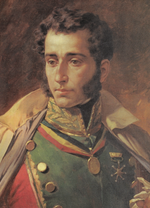 |
Antonio José de Sucre (1795–1830) |
Independent | Received command from Bolívar |
Legal (29 Dec. 1825) [11][10][12] | ||||
| Presidents of the Bolivian Republic (1826–1868)[lower-alpha 6] | ||||||||||
| Presidency[lower-alpha 1] | President | Party | Designation | Government[lower-alpha 2] | Vice President | |||||
| 2 | 25 May 1826 – 18 April 1828 Delegated command – 12 August 1828 Resigned[lower-alpha 7] |
From 25 to 28 May 1826, the presidency was fulfilled by Casimiro Olañeta.[lower-alpha 8] | Legal acting |
Non-existent 6 Aug.1826 – 19 Nov. 1826 [6] | ||||||
 |
Antonio José de Sucre (1795–1830) |
Independent | Elected by the General Constituent Congress |
Legal (28 May 1826) [18][19] | ||||||
| Legal (19 Jun. 1826) [20] | ||||||||||
| Vacant after 19 Nov. 1826 | ||||||||||
| Elected by the General Constituent Congress |
Constitutional (9 Dec. 1826) [21][22] | |||||||||
| 3 | 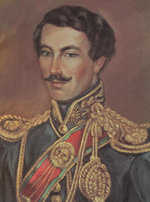 |
José María Pérez de Urdininea (1784–1865) |
Independent | Received command from Sucre (President of the Council of Ministers) Council of Ministers Council of Ministers[23]
|
Constitutional acting (18 Apr. 1828) [24][25][26] | |||||
| 4 | 2 August 1828 – 18 December 1828 End of mandate |
 |
José Miguel de Velasco (1795–1859) |
Independent | Received command from Sucre (President of the Council of Ministers) Council of Ministers Council of Ministers[23]
|
Constitutional acting (2 Aug. 1828) [27] | ||||
| Elected by the General Constituent Congress (Vice President of Santa Cruz) |
Constitutional provisional acting (12 Aug. 1828) [28][lower-alpha 9] |
Themself; charged with State Administration | ||||||||
| From 18 to 26 December 1828, the presidency was fulfilled by José Ramón de Loayza.[lower-alpha 4] | Elected by the General Assembly |
Constitutional provisional acting |
Themself; charged with State Administration | |||||||
| 5 | 26 December 1828 – 1 January 1829 Died in office[lower-alpha 10] |
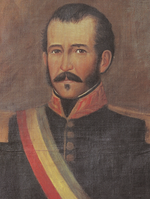 |
Pedro Blanco Soto (1795–1829) |
Independent | Received command from Loayza |
Constitutional provisional [30] |
José Ramón de Loayza | |||
| 4 | 1 January 1829 – 24 May 1829 End of mandate |
 |
José Miguel de Velasco (1795–1859) |
Independent | Elected by the Constituent Congress (Vice President of Santa Cruz) |
Constitutional acting [27][31][lower-alpha 4] |
Themself; charged with State Administration | |||
| 6 | 24 May 1829 – 17 February 1839 Ousted by a coup d'état[lower-alpha 11] |
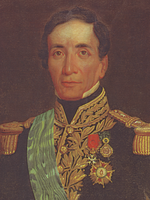 |
Andrés de Santa Cruz (1792–1865) |
Independent | Received command from Velasco |
Constitutional provisional (24 May 1829) [34] |
José Miguel de Velasco | |||
| Elected by the General Constituent Assembly |
Constitutional provisional (16 Jul. 1831) [35] | |||||||||
| Elected by the General Constituent Assembly |
Constitutional (15 Aug. 1831) [36] | |||||||||
| Mariano Enrique Calvo | ||||||||||
| Elected by the parish electoral boards |
Constitutional (16 Aug. 1835) [21] | |||||||||
| Elected by the Tapacarí, Huaura, and Sicuani Congresses |
Constitutional (28 Oct. 1836) [13] | |||||||||
| From 18 July 1838 – 17 February 1839, the presidency was fulfilled by Mariano Enrique Calvo.[lower-alpha 12] | Constitutional acting | |||||||||
| Office vacant 17–22 February 1839.[38][lower-alpha 13] | ||||||||||
| 4 | 22 February 1839 – 10 June 1841 Ousted by a coup d'état |
 |
José Miguel de Velasco (1795–1859) |
Military | Installed by a coup d'état | De facto provisional (22 Feb. 1839) [27][39] |
Vacant through 26 Oct. 1839 | |||
| Elected by the General Constituent Congress |
Constitutional provisional (16 Jun. 1839) [40] | |||||||||
| Office abolished 26 Oct. 1839 – 15 Feb. 1878 [41][42][lower-alpha 14] | ||||||||||
| Elected by the Constitutional Congress |
Constitutional (15 Aug. 1840) [44] | |||||||||
| 7 | 10 June 1841 – 9 July 1841 Resigned |
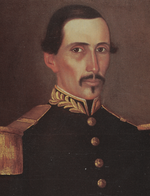 |
Sebastián Ágreda (1795–1875) |
Military | Installed by a coup d'état | De facto provisional [45][lower-alpha 15] | ||||
| 8 | 9 July 1841 – 22 September 1841 Ousted by a coup d'état |
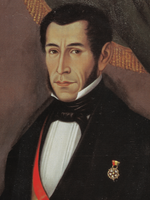 |
Mariano Enrique Calvo (1782–1842) |
Independent | Received command from Ágreda |
De facto acting [47][lower-alpha 15] | ||||
| Office vacant 22–27 September 1841.[38][lower-alpha 16] | ||||||||||
| 9 | 27 September 1841 – 23 December 1847 Resigned |
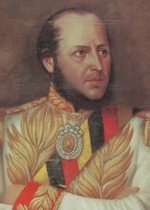 |
José Ballivián (1805–1852) |
Military | Installed by a coup d'état | De facto provisional (27 Sep. 1841) [49][50][51] | ||||
| Elected by the National Convention |
Constitutional provisional (23 Apr. 1843) [52] | |||||||||
| 1844 general election | Constitutional (15 Aug. 1844) [53] | |||||||||
| 10 | 23 December 1847 – 2 January 1848 Ousted by a coup d'état |
 |
Eusebio Guilarte (1805–1849) |
Independent | Constitutional succession (President of the National Council) |
Constitutional acting [54][25][55] | ||||
| Office vacant 2–18 January 1848.[38][lower-alpha 17] | ||||||||||
| 4 | 18 January 1848[lower-alpha 18] – 6 December 1848 Ousted by a coup d'état |
 |
José Miguel de Velasco (1795–1859) |
Military | Installed by a coup d'état | De facto (18 Jan. 1848) [27][57][lower-alpha 19] | ||||
| Elected by the Extraordinary Congress |
De facto provisional (12 Sep. 1848) [58] | |||||||||
| From 12 October – 6 December 1838, the presidency was fulfilled by José María Linares.[59][60] | Constitutional acting | |||||||||
| 11 | 6 December 1848[lower-alpha 20] – 15 August 1855 End of term |
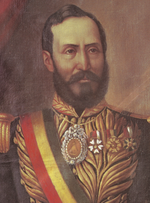 |
Manuel Isidoro Belzu (1802–1865) |
Military | Installed by a coup d'état | De facto provisional (6 Dec. 1848) [62] | ||||
| 1850 general election | Constitutional (15 Aug. 1850) [63][64] | |||||||||
| Dictatorship declared | De facto (7 Sep. 1850) [65][lower-alpha 21] | |||||||||
| Constitutional freedoms restored |
Constitutional (16 Jul. 1851) [21][67] | |||||||||
| 12 | 15 August 1855 – 9 September 1857[lower-alpha 22] Ousted by a coup d'état |
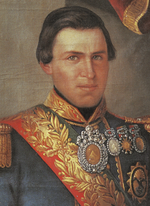 |
Jorge Córdova (1822–1861) |
Independent | 1855 general election | Constitutional [69][70] | ||||
| 13 | 9 September 1857 – 14 January 1861 Ousted by a coup d'état |
 |
José María Linares (1808–1861) |
Independent | Installed by a coup d'état | De facto provisional [71][72] | ||||
| From 14 January – 4 May 1861, the presidency was fulfilled by a junta.
Governmental Junta of the Republic[23][73]
From 9 April 1861:
|
Installed by a coup d'état | De facto | ||||||||
| 14 | 4 May 1861 – 28 December 1864 Ousted by a coup d'état |
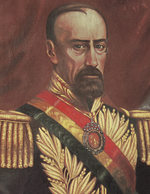 |
José María de Achá (1810–1868) |
Independent | Elected by the Constituent National Assembly |
Constitutional provisional (4 May 1861) [74][75] | ||||
| 1862 general election | Constitutional (15 Aug. 1862) [76] | |||||||||
| 15 | 28 December 1864 – 1 October 1868 Legal change |
 |
Mariano Melgarejo (1820–1871) |
Military | Installed by a coup d'état | De facto provisional (28 Dec. 1864) [77][78] | ||||
| 1868 general election | Constitutional provisional (15 Aug. 1868) [79] | |||||||||
| Presidents of the Republic of Bolivia (1868–2009) | ||||||||||
| Presidency[lower-alpha 1] | President | Party | Designation | Government[lower-alpha 2] | Vice President | |||||
| 15 | 1 October 1868 – 15 January 1871 Ousted by a coup d'état |
 |
Mariano Melgarejo (1820–1871) |
Military | 1868 Political Constitution | Constitutional provisional (15 Aug. 1868) [80] |
Office abolished 26 Oct. 1839 – 15 Feb. 1878 [41][42][lower-alpha 14] | |||
| Dictatorship declared | De facto provisional (3 Feb. 1869) [81] | |||||||||
| Constitutional freedoms restored |
Constitutional provisional (31 May 1869) [82] | |||||||||
| 1870 general election | Constitutional (15 Aug. 1870) [21][83] | |||||||||
| 16 | 15 January 1871[lower-alpha 24] – 27 November 1872 Died in office[lower-alpha 25] |
 |
Agustín Morales (1808–1872) |
Military | Installed by a coup d'état | De facto (15 Jan. 1871) [85] | ||||
| De facto provisional (21 Jan. 1871) [86] | ||||||||||
| Elected by the Constituent Assembly |
De facto provisional (18 Jun. 1871) [87] | |||||||||
| 1872 general election | Constitutional (25 Aug. 1872) [88] | |||||||||
| From 27 to 28 November 1872, the presidency was fulfilled by Juan de Dios Bosque.[lower-alpha 26] | Constitutional succession (President of the National Assembly) |
Constitutional acting | ||||||||
| 17 | 28 November 1872 – 9 May 1873 End of mandate |
 |
Tomás Frías (1804–1884) |
Independent | Constitutional succession (President of the Council of State) |
Constitutional [90][25][91] | ||||
| 18 | 9 May 1873 – 14 February 1874 Died in office[lower-alpha 23] |
 |
Adolfo Ballivián (1831–1874) |
Red[lower-alpha 27] | 1873 general election (Elected by the National Congress)[lower-alpha 28] |
Constitutional [95][96] | ||||
| From 31 January – 14 February 1874, the presidency was fulfilled by Tomás Frías.[lower-alpha 29] | Constitutional acting | |||||||||
| 17 | 14 February 1874 – 4 May 1876 Ousted by a coup d'état |
 |
Tomás Frías (1804–1884) |
Independent | Constitutional succession (President of the Council of State) |
Constitutional [90][25][99] | ||||
| 19 | 4 May 1876 – 28 December 1879 Ousted by a coup d'état |
 |
Hilarión Daza (1840–1894) |
Military | Installed by a coup d'état | De facto provisional (4 May 1876) [100][101] | ||||
| Elected by the Constituent Assembly |
Constitutional provisional (15 Nov. 1877) [102] | |||||||||
| Vacant after 15 Feb. 1878 | ||||||||||
| From 17 April – 28 December 1879, the presidency was fulfilled by the Council of Ministers.[lower-alpha 30]
Government Junta
From 11 September 1879:
|
Constitutional acting | |||||||||
| From 28 December 1879 – 19 January 1880, the presidency was fulfilled by a junta.[lower-alpha 31]
Government Junta Government Junta of La Paz
| ||||||||||
| 20 | 19 January 1880 – 4 September 1884 End of term |
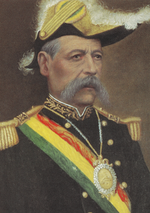 |
Narciso Campero (1813–1896) |
Independent | Received command from the junta |
De facto provisional (19 Jan. 1880) [106] |
Vacant through 31 May 1880 | |||
| Elected by the National Convention |
Constitutional (31 May 1880) [107] |
Aniceto Arce[lower-alpha 32] (1º) | ||||||||
| Vacant after 11 Mar. 1881 | ||||||||||
| Belisario Salinas (2º) | ||||||||||
| 21 | 4 September 1884 – 15 August 1888 End of term |
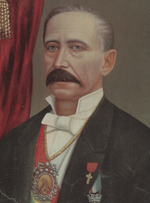 |
Gregorio Pacheco (1823–1899) |
Democratic[lower-alpha 33] | 1884 general election (Elected by the National Congress)[lower-alpha 28] |
Constitutional [109][110] |
Mariano Baptista (1º) | |||
| Conservative | Jorge Oblitas (2º) | |||||||||
| 22 | 15 August 1888 – 11 August 1892 End of term |
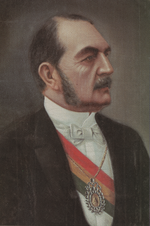 |
Aniceto Arce (1824–1906) |
Conservative | 1888 general election | Constitutional [111][112] |
José Manuel del Carpio (1º) | |||
| Serapio Reyes Ortiz (2º) | ||||||||||
| 23 | 11 August 1892 – 19 August 1896 End of term |
 |
Mariano Baptista (1831–1907) |
Conservative | 1892 general election (Elected by the National Congress)[lower-alpha 28] |
Constitutional [113][114] |
Severo Fernández (1º) | |||
| Vacant throughout presidency [lower-alpha 34] | ||||||||||
| 24 | 19 August 1896 – 12 April 1899 Ousted by the Federal War |
 |
Severo Fernández (1849–1925) |
Conservative | 1896 general election | Constitutional [115][116] |
Rafael Peña (1º) | |||
| Jenaro Sanjinés (2º) | ||||||||||
| From 12 April – 25 October 1899, the presidency was fulfilled by a junta.
|
Installed by the Federal War | De facto | Vacant throughout mandate | |||||||
| 25 | 25 October 1899 – 14 August 1904 End of term |
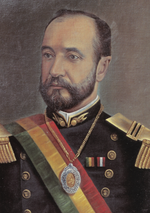 |
José Manuel Pando (1849–1917) |
Liberal | Elected by the National Convention |
Constitutional [118][119] |
Lucio Pérez Velasco[lower-alpha 32] (1º) | |||
| Vacant after 23 Jan. 1903 | ||||||||||
| Aníbal Capriles (2º) | ||||||||||
| 26 | 14 August 1904 – 12 August 1909 End of term[lower-alpha 35] |
 |
Ismael Montes (1861–1933) |
Liberal | 1904 general election | Constitutional [121][122] |
Eliodoro Villazón (1º) | |||
| Valentín Abecia (2º) | ||||||||||
| 27 | 12 August 1909 – 14 August 1913 End of term |
 |
Eliodoro Villazón (1848–1939) |
Liberal | 1909 presidential election | Constitutional [123][124] |
Macario Pinilla (1º) | |||
| Juan Misael Saracho [lower-alpha 36] | ||||||||||
| 26 | 14 August 1913 – 15 August 1917 End of term |
 |
Ismael Montes (1861–1933) |
Liberal | 1913 presidential election | Constitutional [121][125] | ||||
| Vacant after 1 Oct. 1915 | ||||||||||
| José Carrasco (2º) | ||||||||||
| 28 | 15 August 1917 – 12 July 1920 Ousted by a coup d'état |
 |
José Gutiérrez Guerra (1869–1929) |
Liberal | 1917 presidential election | Constitutional [126][127] |
Ismael Vázquez (1º) | |||
| José Santos Quinteros (2º) | ||||||||||
| From 13 July 1920 – 28 January 1921, the presidency was fulfilled by a junta.
|
Installed by a coup d'état | De facto | Vacant throughout mandate | |||||||
| 29 | 28 January 1921 – 3 September 1925 End of term |
 |
Bautista Saavedra (1870–1939) |
Republican | Elected by the National Convention |
Constitutional [130][131] |
Vacant throughout presidency [lower-alpha 37] | |||
| 30 | 3 September 1925 – 10 January 1926 End of mandate |
 |
Felipe Segundo Guzmán (1879–1932) |
Republican | Constitutional succession (President of the National Senate) |
Constitutional provisional [135][136][137] |
Vacant throughout presidency | |||
| 31 | 10 January 1926 – 28 May 1930 Resigned |
 |
Hernando Siles Reyes (1882–1942) |
Republican[lower-alpha 38] | 1925 general election | Constitutional [139] |
Abdón Saavedra | |||
| Nationalist | ||||||||||
| From 28 May – 28 June 1930, the presidency was fulfilled by the council of ministers.
Council of Ministers Council of Ministers[23]
|
Received command from Siles Reyes |
De facto [lower-alpha 40] |
Vacant throughout mandate | |||||||
| 32 | 28 June 1930 – 5 March 1931 End of mandate |
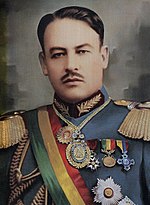 |
Carlos Blanco Galindo (1882–1943) |
Military | Installed by a coup d'état
Government Junta Military Government Junta[23][144]
From 2 July 1930:
|
De facto [148] |
Vacant throughout presidency | |||
| 33 | 5 March 1931 – 1 December 1934 Ousted by a coup d'état |
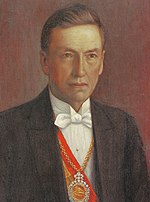 |
Daniel Salamanca (1869–1935) |
Genuine Republican |
1931 general election | Constitutional [149][150] |
José Luis Tejada Sorzano | |||
| From 28 November – 1 December 1934, the presidency was fulfilled by José Luis Tejada Sorzano.[lower-alpha 42] | Constitutional acting | |||||||||
| 34 | 1 December 1934 – 17 May 1936 Ousted by a coup d'état |
 |
José Luis Tejada Sorzano (1882–1938) |
Liberal | Unconstitutional succession (Vice President of Salamanca) |
De facto [153][lower-alpha 43] |
Vacant throughout presidency | |||
| From 17 to 22 May 1936, the presidency was fulfilled by Germán Busch.[lower-alpha 4]
Mixed Government Junta[23][155]
|
Installed by a coup d'état | De facto provisional |
Vacant throughout mandate | |||||||
| 35 | 22 May 1936 – 13 July 1937 Ousted by a coup d'état |
 |
David Toro (1898–1977) |
Military Socialist [lower-alpha 44] |
Succeeded to lead the junta
Government Junta[23][lower-alpha 45]
|
De facto [159] |
Vacant throughout presidency | |||
| 36 | 13 July 1937 – 23 August 1939 Died in office[lower-alpha 46] |
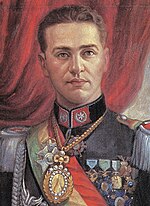 |
Germán Busch (1903–1939) |
Military Socialist [lower-alpha 44] |
Succeeded to lead the junta[lower-alpha 47]
Military Government Junta[162][lower-alpha 48]
|
De facto (13 Jul. 1937) [163][164] |
Vacant through 28 May 1938 | |||
| Elected by the National Convention |
Constitutional (28 May 1938) [165] |
Enrique Baldivieso | ||||||||
| Dictatorship declared | De facto (24 Apr. 1939) [166] |
Vacant after 24 Apr. 1939 [lower-alpha 49] | ||||||||
| 37 | 23 August 1939 – 15 April 1940 End of mandate |
 |
Carlos Quintanilla (1888–1964) |
Military | Installed by a coup d'état | De facto provisional [169][170] |
Vacant through 4 Dec. 1939 | |||
| Office abolished 4 Dec. 1939 – 6 Nov. 1945 [171][172] | ||||||||||
| 38 | 15 April 1940 – 20 December 1943 Ousted by a coup d'état |
 |
Enrique Peñaranda (1892–1969) |
Concordance | 1940 general election | Constitutional [173][174] | ||||
| 39 | 20 December 1943 – 21 July 1946 Resigned[lower-alpha 50] |
 |
Gualberto Villarroel (1908–1946) |
Reason for the Fatherland |
Installed by a coup d'état
Government Junta[162]
From 11 February 1944:[176]
|
De facto (20 Dec. 1943) [177] | ||||
| Received command from the junta |
De facto provisional (5 Apr. 1944) [178] | |||||||||
| Elected by the National Convention |
Constitutional (6 Aug. 1944) [179] | |||||||||
| Julián Montellano | ||||||||||
| Briefly on 21 July 1946, the presidency was fulfilled by Dámaso Arenas.[lower-alpha 51] | Unconstitutional succession (Commander-in-chief of the military) |
De facto | Vacant throughout presidency | |||||||
| 40 | 21 July 1946 – 17 August 1946 End of mandate |
 |
Néstor Guillén (1890–1966) |
Independent | Installed by a popular uprising
Superior Court of Justice of
Government Junta
Provisional Government Junta |
De facto [180] |
Vacant throughout presidency | |||
| 41 | 17 August 1946 – 10 March 1947 End of mandate |
 |
Tomás Monje (1884–1954) |
Independent | Succeeded to lead the junta
|
De facto [181] |
Vacant throughout presidency | |||
| 42 | 10 March 1947 – 22 October 1949 Resigned |
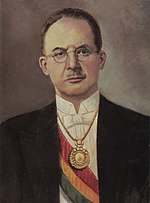 |
Enrique Hertzog (1897–1981) |
Republican Socialist Unity |
1947 general election (Elected by the National Congress)[lower-alpha 28] |
Constitutional [182][183] |
Mamerto Urriolagoitía | |||
| From 7 May – 22 October 1949, the presidency was fulfilled by Mamerto Urriolagoitía.[lower-alpha 53] | Constitutional acting | |||||||||
| From 22 to 24 October 1949, the presidency was fulfilled by Mamerto Urriolagoitía.[lower-alpha 53] | ||||||||||
| 43 | 24 October 1949 – 16 May 1951 Resigned |
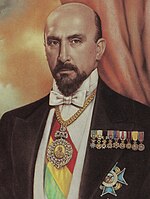 |
Mamerto Urriolagoitía (1895–1974) |
Republican Socialist Unity |
Constitutional succession (Vice President of Hertzog) |
Constitutional [186][187] |
Vacant throughout presidency | |||
| 44 | 16 May 1951 – 11 April 1952 Ousted by the National Revolution |
 |
Hugo Ballivián (1901–1993) |
Military | Installed by a self-coup
|
De facto [190][191] |
Vacant throughout presidency | |||
| From 11 to 15 April 1952, the presidency was fulfilled by Hernán Siles Zuazo.[lower-alpha 4] | Installed by the National Revolution |
De facto provisional (11 Apr. 1952) |
Vacant throughout presidency | |||||||
| De facto acting (12 Apr. 1952) |
Themself; charged with State Administration | |||||||||
| 45 | 15 April 1952 – 6 August 1956 End of term |
 |
Víctor Paz Estenssoro (1907–2001) |
Revolutionary Nationalist |
Received command from Siles Zuazo |
De facto [192][lower-alpha 54] |
Hernán Siles Zuazo | |||
| 46 | 6 August 1956 – 6 August 1960 End of term |
 |
Hernán Siles Zuazo (1914–1996) |
Revolutionary Nationalist |
1956 general election | Constitutional [193][194] |
Ñuflo Chávez Ortiz[lower-alpha 55] | |||
| Vacant after 24 Jun. 1957 | ||||||||||
| 45 | 6 August 1960 – 4 November 1964 Ousted by a coup d'état |
 |
Víctor Paz Estenssoro (1907–2001) |
Revolutionary Nationalist |
1960 general election | Constitutional [192][195][196] |
Juan Lechín | |||
| 1964 general election | René Barrientos | |||||||||
| From 4–5 November 1964, the presidency was fulfilled by a junta.
Government Junta Military Government Junta[188][lower-alpha 56] From 5 November:[198]
|
Installed by a coup d'état | De facto | Vacant throughout mandate | |||||||
| 47 | 5 November 1964 – 26 May 1965 Legal change |
 |
René Barrientos (1919–1969) |
Military | Succeeded to lead the junta
Government Junta Military Government Junta[188]
|
De facto [199][200] |
Vacant throughout presidency | |||
| 26 May 1965 – 2 January 1966 Barrientos resigned |
Co-presidency of the junta[lower-alpha 57]
Government Junta Military Government Junta[188]
| |||||||||
| 48 |  |
Alfredo Ovando Candía (1918–1982) |
Military | De facto [201][202] |
Vacant throughout presidency | |||||
| 2 January 1966 – 6 August 1966 End of mandate |
Succeeded to lead the junta
Government Junta Military Government Junta[188]
| |||||||||
| 47 | 6 August 1966 – 27 April 1969 Died in office[lower-alpha 58] |
 |
René Barrientos (1919–1969) |
Popular Christian |
1966 general election | Constitutional [199] |
Luis Adolfo Siles Salinas | |||
| 49 | 27 April 1969 – 26 September 1969 Ousted by a coup d'état |
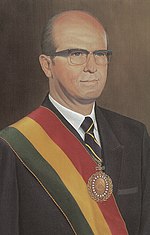 |
Luis Adolfo Siles Salinas (1925–2005) |
Social Democratic |
Constitutional succession (Vice President of Barrientos) |
Constitutional [204][205] |
Vacant throughout presidency | |||
| 48 | 26 September 1969 – 6 October 1970 Ousted by a coup d'état |
 |
Alfredo Ovando Candía (1918–1982) |
Military Nationalist [lower-alpha 44] |
Installed by a coup d'état | De facto [201][206][lower-alpha 59] |
Vacant throughout presidency | |||
| Briefly on 6 October 1970, the presidency was fulfilled by Rogelio Miranda.[lower-alpha 60] | Installed by a coup d'état | De facto | Vacant throughout presidency | |||||||
| From 6–7 October 1970, the presidency was fulfilled by a junta.
|
De facto | Vacant throughout mandate | ||||||||
| 50 | 7 October 1970 – 21 August 1971 Ousted by a coup d'état |
 |
Juan José Torres (1920–1976) |
Military Nationalist [lower-alpha 44] |
Installed by a coup d'état | De facto [210][lower-alpha 59] |
Vacant throughout presidency | |||
| 51 | 21 August 1971 – 21 July 1978 Resigned |
From 21 to 22 August 1971, the presidency was fulfilled by a junta.
Government Junta
|
Installed by a coup d'état | De facto [211] |
Vacant throughout mandate | |||||
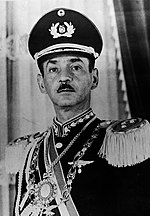 |
Hugo Banzer (1926–2002) |
Military | Received command from the junta |
De facto [212][213] |
Vacant throughout presidency | |||||
| Briefly on 21 July 1978, the presidency was fulfilled by a junta.
Junta of Commanders of the Armed Forces[5]
|
Received command from Banzer |
De facto [214] |
Vacant throughout mandate | |||||||
| 52 | 21 July 1978 – 24 November 1978 Ousted by a coup d'état |
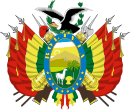 |
Juan Pereda (1931–2012) |
Military | Installed by a coup d'état | De facto [215] |
Vacant throughout presidency | |||
| 53 | 24 November 1978 – 8 August 1979 End of mandate |
 |
David Padilla (1927–2016) |
Military | Installed by a coup d'état
Government Junta Military Government Junta[216]
|
De facto [217] |
Vacant throughout presidency | |||
| 54 | 8 August 1979 – 1 November 1979 Ousted by a coup d'état[lower-alpha 61] |
 |
Wálter Guevara (1912–1996) |
Authentic Revolutionary |
Elected by the National Congress (President of the National Senate) |
Constitutional acting [219][220][25][lower-alpha 62] |
Vacant throughout presidency | |||
| 55 | 1 November 1979 – 16 November 1979 Resigned |
 |
Alberto Natusch (1933–1994) |
Military | Installed by a coup d'état | De facto [221][222] |
Vacant throughout presidency | |||
| 56 | 16 November 1979 – 17 July 1980 Ousted by a coup d'état |
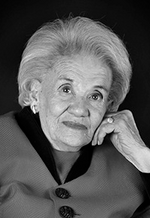 |
Lidia Gueiler (1921–2011) |
Revolutionary Nationalist Left |
Elected by the National Congress (President of the Chamber of Deputies) |
Constitutional acting [223][25][lower-alpha 62] |
Vacant throughout presidency | |||
| 57 | 17 July 1980 – 4 August 1981 Resigned |
From 17 to 18 July 1980, the presidency was fulfilled by a junta.
Junta of Commanders of the Armed Forces of the Nation[188]
|
Installed by a coup d'état | De facto | Vacant throughout mandate | |||||
 |
Luis García Meza (1929–2018) |
Military | Received command from the junta |
De facto [224] |
Vacant throughout presidency | |||||
| From 4 August – 4 September 1981, the presidency was fulfilled by a junta.
|
Received command from García Meza |
De facto [226] |
Vacant throughout mandate | |||||||
| 58 | 4 September 1981 – 19 July 1982 Resigned |
 |
Celso Torrelio (1933–1999) |
Military | Received command from the junta |
De facto [227] |
Vacant throughout presidency | |||
| From 19 to 21 July 1982, the presidency was fulfilled by a junta.
|
Received command from Torrelio |
De facto [228] |
Vacant throughout mandate | |||||||
| 59 | 21 July 1982 – 10 October 1982 End of mandate |
 |
Guido Vildoso (born 1937) |
Military | Received command from the junta |
De facto [229] |
Vacant throughout presidency | |||
| 46 | 10 October 1982 – 6 August 1985 End of term[lower-alpha 63] |
 |
Hernán Siles Zuazo (1914–1996) |
Leftwing Revolutionary Nationalist |
1980 general election (Elected by the National Congress)[lower-alpha 64] |
Constitutional [193][232] |
Jaime Paz Zamora [lower-alpha 55][233] | |||
| Vacant after 14 Dec. 1984 | ||||||||||
| 45 | 6 August 1985 – 6 August 1989 End of term |
 |
Víctor Paz Estenssoro (1907–2001) |
Revolutionary Nationalist |
1985 general election (Elected by the National Congress)[lower-alpha 28] |
Constitutional [192][234] |
Julio Garrett Ayllón | |||
| 60 | 6 August 1989 – 6 August 1993 End of term |
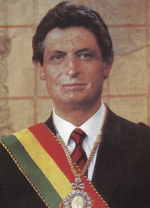 |
Jaime Paz Zamora (born 1939) |
Revolutionary Left |
1989 general election (Elected by the National Congress)[lower-alpha 28] |
Constitutional [235][236] |
Luis Ossio[lower-alpha 65] | |||
| 61 | 6 August 1993 – 6 August 1997 End of term |
 |
Gonzalo Sánchez de Lozada (born 1930) |
Revolutionary Nationalist |
1993 general election (Elected by the National Congress)[lower-alpha 28] |
Constitutional [238][239] |
Víctor Hugo Cárdenas | |||
| 51 | 6 August 1997 – 7 August 2001 Resigned |
 |
Hugo Banzer (1926–2002) |
Nationalist Democratic Action |
1997 general election (Elected by the National Congress)[lower-alpha 28] |
Constitutional [212][240] |
Jorge Quiroga | |||
| From 1 July – 7 August 2001, the presidency was fulfilled by Jorge Quiroga.[241] | Constitutional acting | |||||||||
| 62 | 7 August 2001 – 6 August 2002 End of term |
 |
Jorge Quiroga (born 1960) |
Nationalist Democratic Action |
Constitutional succession (Vice President of Banzer) |
Constitutional [242] |
Vacant throughout presidency | |||
| 61 | 6 August 2002 – 17 October 2003 Resigned |
 |
Gonzalo Sánchez de Lozada (born 1930) |
Revolutionary Nationalist |
2002 general election (Elected by the National Congress)[lower-alpha 28] |
Constitutional [238][243] |
Carlos Mesa | |||
| 63 | 17 October 2003 – 9 June 2005 Resigned |
 |
Carlos Mesa (born 1953) |
Independent | Constitutional succession (Vice President of Sánchez de Lozada) |
Constitutional [244] |
Vacant throughout presidency | |||
| 64 | 9 June 2005 – 22 January 2006 End of mandate |
 |
Eduardo Rodríguez Veltzé (born 1956) |
Independent | Constitutional succession (President of the Supreme Court) |
Constitutional [25][245] |
Vacant throughout presidency | |||
| 65 | 22 January 2006 – 7 February 2009 Legal change |
 |
Evo Morales (born 1959) |
Movement for Socialism |
2005 general election | Constitutional [246] |
Álvaro García Linera | |||
| Presidents of the Plurinational State of Bolivia (2009–present) | ||||||||||
| Presidency[lower-alpha 1] | President | Party | Designation | Government[lower-alpha 2] | Vice President | |||||
| 65 | 7 February 2009 – 10 November 2019 Resigned[lower-alpha 66] |
 |
Evo Morales (born 1959) |
Movement for Socialism |
2009 Political Constitution | Constitutional [248][249][250] |
Álvaro García Linera | |||
| 2009 general election | ||||||||||
| 2014 general election | ||||||||||
| Office vacant 10–12 November 2019. | ||||||||||
| 66 | 12 November 2019 – 8 November 2020 End of mandate |
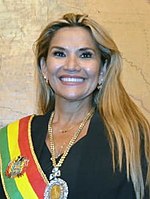 |
Jeanine Áñez (born 1967) |
Social Democratic |
Constitutional succession (President of the Senate Chamber)[lower-alpha 67] |
Constitutional [25][252][253][lower-alpha 68] |
Vacant throughout presidency | |||
| 67 | 8 November 2020 – Incumbent |
 |
Luis Arce (born 1963) |
Movement for Socialism |
2020 general election | Constitutional [255][256] |
David Choquehuanca | |||
| Presidency[lower-alpha 1] | President | Party | Designation | Government[lower-alpha 2] | Vice President | |||||

Notes
- Presidents are categorized into two groups based on the legality of their arrival to power. Constitutional governments came to power through means prescribed by the Constitution of the time, typically through democratic election or by constitutional succession. De facto governments arrived to power through explicitly unconstitutional means, most commonly through coups d'état or a delegation of power not prescribed by the Constitution. Such de facto governments can become constitutional later either through the calling of democratic elections or the enactment of a new constitution.
- Maximum authority of the country until the arrival of Bolívar.[5]
- Exerts command pending the arrival of the president-designate.[5]
- Simultaneously Supreme Protector of the Peru-Bolivian Confederation from 28 October 1836 – 20 February 1839.[13]
- On 18 April 1828, Sucre delegated command to the council of ministers, presided by José María Pérez de Urdininea. At that time, Sucre did not resign. It was not until 2 August that he presented his definitive resignation to the Congress. Simultaneously, a new cabinet was appointed by decree, presided by José Miguel de Velasco.[14][15][16]
- Pending the reception of orders from Peru recognising national independence, the military authority transfers its functions to a General Constituent Congress, presided by Casimiro Olañeta and convened at Chuquisaca.[17]
- Assassinated 1 January 1878.[2]
- The Constitution of 1839 eliminated the vicepresidential position. In replacement, constitutional succession corresponds to the President of the Senate (Art. 69–71). This was modified on several occasions, corresponding to: the President of the National Council (1843: Art. 53–55); the Council of Ministers, which appoints a president from among its members (1851: Art. 73); the President of the Council of State (1861: Art. 53); the Council of Ministers as a whole (1868: Art. 67); the President of the Council of State (1871: Art. 70). The Constitution of 1878 (Art. 77) reestablished the vice presidency after 39 years.[43]
- Acting for Andrés de Santa Cruz (in exile) who never took office.[46]
- On 22 September 1841, José Ballivián overthrew Calvo; days before, both Ballivián and José Miguel de Velasco at different points had disregarded the president and proclaimed themselves as heads of the republic. Between the day of the coup d'état and 27 September, the situation was on one side a vacancy of command and on the other simultaneous command of the country. Velasco in the south and Ballivián in La Paz proclaimed themselves president. Finally on the twenty-seventh, Ballivián was sworn-in to the presidency after five days of uncertainty.[48]
- After ten days in office, Guilarte left the executive due to the army uprising in Oruro, causing another period of vacancy. Manuel Isidoro Belzu was proclaimed president (December of 1847) in La Paz, while José Miguel de Velasco was declared in the south. The situation remained unclear until 18 January and Velasco's swearing-in.[48]
- In dissidence since 2 November 1847.[56]
- Occasionally styled "Legal President of the Republic".[57]
- In dissidence since 12 October 1848.[61]
- The government became de facto on 7 September 1850 when the Congress declared itself empowered to adopt dictatorial measures. On 16 October, a dictatorship was formally established when Belzu assumed supreme command, with the use of extraordinary powers. Despite this, official records of the time continued refer to him as the Constitutional President of the Republic.[66]
- The overthrown government continued in dissidence until 21 October.[68]
- Died in office of natural causes.[2]
- In dissidence since 26 November 1870.[84]
- Assassinated 27 November 1872.[2]
- It is agreed by legal records and scholarly sources that Morales died on 27 November and Tomás Frías assumed office on 28 November. However, some texts in the list of presidents of Bolivia include Juan de Dios Bosque as acting president from the night of the 27th to the 28th. Why some sources include Bosque and others omit him is unclear, though it is possibly due to the fact that executive power was transferred to him automatically and not through any formal processes.[89]
- The Red Party, which was the origin of the Conservative and Liberal parties, was the faction which presented Ballivián in the 1873 election.[92] Prior to 1880, groups such as the Reds did not yet possess a programmatic and ideological structure that would allow them to be defined as proper political parties.[93]
- Since the majority candidate did not achieve 51% of the total votes cast, Congress was responsible for the election of the president among the three most voted candidates. In all but two of these cases, it elected the winner of the popular vote plurality. In 1985, the Congress elected the second in the popular vote and in 1989 it elected the third in the popular vote.[94]
- On 17 April 1879, Daza delegated command to his council of ministers while he took command of the armed forces in the War of the Pacific. Given the absence of Minister of Government Serapio Reyes Ortiz, Pedro José de Guerra, senior minister of the Supreme Court, was entrusted to precide over the council of ministers. On 11 September, de Guerra died and was replaced by Reyes Ortiz.[103]
- When Daza was overthrown in Tacna, several uprisings took place. The most important of these is that of La Paz in which a civil-military junta was proclaimed. The junta was not recognized by any of the remaining Bolivian departments. For this reason, this period is regarded as the fourth period of nationwide lack of government lasting more than 24 hours. The junta lasted until 19 January 1880 when it dissolved itself and, by decree, designated Narciso Campero as president by proclamation of the Republic, this time accepted by the entire country.[38]
- Dismissed and exiled from the country.[108]
- The second vice presidency remains vacant due to the death of Juan Federico Zuazo before taking office.[114]
- Montes' term of office was extended by one year due to the death of the president-elect Fernando Eloy Guachalla before taking office.[120]
- Siles Reyes was elected president on the Republican Party ticket. His policy priorities as president soon proved to be opposed to most of the Republican agenda, and he formed the National Union Party in early 1927, later rebranded as the Nationalist Party.[138]
- On 28 June 1930, Vega resigned from the full cabinet but remained part of the council of ministers.[141]
- According to the Constitution, Siles Reyes, upon resigning, was required to hand over command to the vice president (absent). By order of institutional succession, command successively corresponded to the presidents of the Senate, of the Chamber of Deputies, or of the Supreme Court. By handing over the command to the Council of Ministers, it takes away the constitutional validity of the new administration.[97]
- The "Statute of Government" of 29 June 1930, which served as the organising charter of the junta, did not specify a chairman; but did institute a council of ministers, consisting of all the members of the junta, with Carlos Blanco Galindo as president of the council, without portfolio.[145]
- Upon assuming office, an attempt was made to give Tejada Sorzano a veneer of legality through the guise of constitutional succession to what in reality was a coup d'état.[97] Though his capacity as vice president made him constitutionally capable of succeeding to office, the circumstances make his a de facto government.[154] Despite this, official records of the time refer to him as the Constitutional President of the Republic.[152]
- In the case of the denominated periods of military nationalism/socialism, the definition can not be said to be exact, although it is evident that it includes a phenomenon of left-wing governments of a military nature. The government of Gulaberto Villarroel is also included in this group, which appears under the RADEPA moniker. The word "nationalism" has been used especially since 1964 by practically all military governments, although its meaning in the cases not mentioned by this note has not had either the content or governing sense of the governments listed.[157]
- From 21 June 1936, the civil-military government is terminated and the Government Junta modified into the Military Government Junta.[158]
- Committed suicide 23 August 1939; see Germán Busch § Death and controversy for further details.[2] The circumstances of his death are a source of controversy.[160]
- Busch enacted a coup d'état which overthrew Toro but not the government junta over which he presided.[161]
- The junta undergoes several modifications under Busch's mandate. Only the original composition is represented here.[161]
- Assassinated 21 July 1946; see 1946 La Paz riots for further details.[2] Villarroel presented his resignation hours prior to being victimized.[175]
- Villarroel resigned in favor of General Dámaso Arenas, then commander-in-chief of the armed forces. There is no record that Arenas was ever sworn-in as president.[5]
- The junta was modified on three occasions: On 21 July, it was formed from the magistrates of the Superior Court of Justice of the Judicial District of La Paz. On 22 July, participation in the junta was extended to other sectors and its membership reduced. Finally on 24 July, representatives of the labor, student, and teaching sectors entered.[162]
- When the presidency was handed over to Víctor Paz Estenssoro after the revolutionary triumph, an attempt was made to validate the electoral victory of the MNR in 1951 (popular vote plurality). Legally it is not possible to subjectively and retroactively apply an action concluded in May 1951. For this reason this government is considered de facto.[97] Despite this, official records of the time refer to him as the Constitutional President of the Republic.
- Resigned from office.[108]
- On 4 November 1964, General Ovando Candía announced the formation of a military junta which he would head. However, "it was not at all clear who was in control" as both he and Barrientos vied for leadership of the government.[197] On 5 November, both were sworn-in as co-chairmen of the junta but Ovando Candía resigned an hour later.[5]
- On 26 May 1965, Barrientos designated Ovando Candía as co-president of the junta, a unique case in the history of Bolivia and the Americas. Both individuals held the executive simultaneously until 2 January 1966 when Barrientos resigned to qualify as a candidate in the 1966 general election.[161]
- Died in a helicopter accident 27 April 1969.[2] The circumstances of his death are a source of controversy.[203]
- After the resignation of Ovando Candía, "the official spokesman for the movement headed by Miranda [...] released a statement indicating that the Army commander headed the Military Government Junta". Despite the proclamation, he renounced the position in favor of a military junta. Having never been sworn-in, he thus isn't considered to have officially taken office.[209]
- The overthrown government continued in dissidence until 16 November.[218]
- In the case of Wálter Guevara and Lidia Gueiler, they were erroneously referred to as acting when in fact they had a provisional character.[97]
- In July 1980, a coup d'état annulled the results of that year's general elections. In 1982 the military, pressured by the demands of various sectors of the country, opted not to hold new elections and instead summoned the Congress elected in 1980 which elected Siles Zuazo from among the three most voted candidates.[94]
- Paz Zamora contested the 1989 election with Gustavo Fernández Saavedra as his running mate. However, in order to secure the support of the ADN in the congressional ballot, the MIR agreed to exchange Fernández Saavedra with Hugo Banzer's running mate Luis Ossio.[237]
- Morales and the Movement for Socialism maintain that he was ousted by a coup d'état.[247]
- Áñez, second vice president of the Senate, first proclaimed herself president of the Upper House, in the absence of the head of the body and the first vice president before moments later using that position as a basis to claim constitutional succession to the presidency.[251]
- The Movement for Socialism maintains that the presidency of Jeanine Áñez was unconstitutional and a de facto government.[254]
Footnotes
- Mesa Gisbert 2003, p. 41
- Mesa Gisbert 2003, pp. 256–257
- Mesa Gisbert 2003, p. 134
- Paredes, Norberto (13 November 2019). "Evo Morales: ¿hubo un golpe de Estado en Bolivia? BBC Mundo consultó a 6 expertos". BBC Mundo (in Spanish). Retrieved 26 October 2021.
- Mesa Gisbert 2003, p. 247
- "Constitución Política de 1826". Gaceta Oficial del Estado Plurinacional de Bolivia (in Spanish). 19 November 1826. Retrieved 25 October 2021.
- Muguértegui, Roy (11 March 2011). "Isaac Sandoval: "Bolívar no fue el primer presidente de Bolivia"". eju.tv (in Spanish). Retrieved 24 October 2021.
- Mendoza, Luz (19 December 2011). "¿Quién fue el primer presidente de Bolivia?; se enciende el debate por el cargo de Simón Bolívar". eju.tv (in Spanish). Retrieved 24 October 2021.
- Mesa Gisbert 2003, p. 564
- "Decreto Supremo de 29 de diciembre de 1825". Gaceta Oficial del Estado Plurinacional de Bolivia (in Spanish). 29 December 1825. Retrieved 24 October 2021.
- Mesa Gisbert 2003, p. 566
- "Decreto Supremo de 13 de enero de 1826". Gaceta Oficial del Estado Plurinacional de Bolivia (in Spanish). 13 January 1826. Retrieved 25 October 2021.
- "Decreto Supremo de 28 de octubre de 1836". Gaceta Oficial del Estado Plurinacional de Bolivia (in Spanish). 28 October 1836. Retrieved 25 October 2021.
- Mesa Gisbert 2003, p. 24
- Ayuso, Fernando (1832). Representacion al Soberano Congreso del Perú, en la presente lejislatura por la H. Cámara de senadores [...] (in Spanish). pp. 23–24.
- "Ley de 12 de agosto de 1828". Gaceta Oficial del Estado Plurinacional de Bolivia (in Spanish). 12 August 1828. Retrieved 25 October 2021.
- Lecuna, Vicente (1995). Documentos referentes a la creación de Bolivia (in Spanish). Vol. 2. Comisión Nacional del Bicentenario del Gran Mariscal Sucre. pp. 153–159. ISBN 9789800723531.
- "Ley de 26 de mayo de 1826". Gaceta Oficial del Estado Plurinacional de Bolivia (in Spanish). 26 May 1826. Retrieved 25 October 2021.
- "Ley de 27 de mayo de 1826". Gaceta Oficial del Estado Plurinacional de Bolivia (in Spanish). 27 May 1826. Retrieved 25 October 2021.
- "Ley de 19 de junio de 1826". Gaceta Oficial del Estado Plurinacional de Bolivia (in Spanish). 19 June 1826. Retrieved 25 October 2021.
- Mesa Gisbert 2003, pp. 268–269
- "Ley de 9 de diciembre de 1826". Gaceta Oficial del Estado Plurinacional de Bolivia (in Spanish). 9 December 1826. Retrieved 25 October 2021.
- Mesa Gisbert 2003, p. 270
- Mesa Gisbert 2003, p. 568
- Baptista Morales, José Luis (28 March 2021). "Presidentes constitucionales interinos". Los Tiempos (in Spanish). Retrieved 19 October 2021.
- "Decreto Supremo de 18 de abril de 1828". Gaceta Oficial del Estado Plurinacional de Bolivia (in Spanish). 18 April 1828. Retrieved 25 October 2021.
- Mesa Gisbert 2003, p. 570
- "Ley de 12 de agosto de 1828". Gaceta Oficial del Estado Plurinacional de Bolivia (in Spanish). 12 August 1828. Retrieved 25 October 2021.
- "Ley de 12 de agosto de 1828". Gaceta Oficial del Estado Plurinacional de Bolivia (in Spanish). 12 August 1828. Retrieved 25 October 2021.
- Mesa Gisbert 2003, p. 574
- "Decreto Supremo de 31 de enero de 1829". Gaceta Oficial del Estado Plurinacional de Bolivia (in Spanish). 23 January 1829. Retrieved 25 October 2021.
- Mesa Gisbert 2003, p. 102
- "Decreto Supremo de 20 de febrero de 1839". Gaceta Oficial del Estado Plurinacional de Bolivia (in Spanish). 20 February 1839. Retrieved 26 October 2021.
- Mesa Gisbert 2003, p. 576
- "Ley de 15 de julio de 1831". lexivox.org (in Spanish). 15 July 1831. Retrieved 25 October 2021.
- "Constitución Política de 1831". Gaceta Oficial del Estado Plurinacional de Bolivia (in Spanish). 14 August 1831. Retrieved 25 October 2021.
- "Decreto Supremo de 18 de julio de 1838". scholarship.rice.edu (in Spanish). 18 July 1838. Retrieved 25 October 2021.
- Mesa Gisbert 2003, p. 273
- "Decreto Supremo de 22 de febrero de 1839". Gaceta Oficial del Estado Plurinacional de Bolivia (in Spanish). 22 February 1839. Retrieved 25 October 2021.
- "Ley de 16 de junio de 1839". Gaceta Oficial del Estado Plurinacional de Bolivia (in Spanish). 16 June 1839. Retrieved 25 October 2021.
- "Constitución Política 1839". Gaceta Oficial del Estado Plurinacional de Bolivia (in Spanish). 26 October 1839. Retrieved 25 October 2021.
- "Constitución Política de 1878". Gaceta Oficial del Estado Plurinacional de Bolivia (in Spanish). 15 February 1878. Retrieved 25 October 2021.
- Mesa Gisbert 2003, pp. 13–14
- "Ley de 14 de agosto de 1840". Gaceta Oficial del Estado Plurinacional de Bolivia (in Spanish). 14 August 1840. Retrieved 25 October 2021.
- Mesa Gisbert 2003, p. 578
- Mesa Gisbert 2003, pp. 102–103
- Mesa Gisbert 2003, p. 580
- Mesa Gisbert 2003, p. 103
- Mesa Gisbert 2003, p. 582
- "Decreto Supremo de 27 de septiembre de 1841". Gaceta Oficial del Estado Plurinacional de Bolivia (in Spanish). 27 September 1841. Retrieved 24 October 2021.
- "Decreto Supremo de 27 de septiembre de 1841". Gaceta Oficial del Estado Plurinacional de Bolivia (in Spanish). 27 September 1841. Retrieved 24 October 2021.
- "Ley de 23 de abril de 1943". lexivox.org (in Spanish). 23 April 1943. Retrieved 24 October 2021.
- "Ley de 14 de agosto de 1844". lexivox.org (in Spanish). 14 August 1844. Retrieved 24 October 2021.
- Mesa Gisbert 2003, p. 584
- "Decreto Supremo de 23 de diciembre de 1847". Gaceta Oficial del Estado Plurinacional de Bolivia (in Spanish). 23 December 1847. Retrieved 24 October 2021.
- "Decreto Supremo de 2 de noviembre de 1847". Gaceta Oficial del Estado Plurinacional de Bolivia (in Spanish). 2 November 1847. Retrieved 24 October 2021.
- "Decreto Supremo de 18 de enero de 1848". Gaceta Oficial del Estado Plurinacional de Bolivia (in Spanish). 18 January 1848. Retrieved 24 October 2021.
- "Ley de 12 de septiembre de 1848". Gaceta Oficial del Estado Plurinacional de Bolivia (in Spanish). 12 September 1848. Retrieved 24 October 2021.
- "Ley de 11 de octubre de 1848". Gaceta Oficial del Estado Plurinacional de Bolivia (in Spanish). 11 October 1848. Retrieved 27 October 2021.
- "Decreto Supremo de 12 de octubre de 1848". Gaceta Oficial del Estado Plurinacional de Bolivia (in Spanish). 12 October 1848. Retrieved 27 October 2021.
- Bolivia (1905). "Presidencia de la República". Anuario administrativo. p. 153. Retrieved 28 October 2021.
- Mesa Gisbert 2003, p. 586
- "Ley de 6 de agosto de 1850". Gaceta Oficial del Estado Plurinacional de Bolivia (in Spanish). 6 August 1850. Retrieved 24 October 2021.
- "Ley de 14 de agosto de 1850". Gaceta Oficial del Estado Plurinacional de Bolivia (in Spanish). 14 August 1850. Retrieved 24 October 2021.
- "Ley de 7 de septiembre de 1850". Gaceta Oficial del Estado Plurinacional de Bolivia (in Spanish). 7 September 1850. Retrieved 24 October 2021.
- "Decreto Supremo de 16 de octubre de 1850". Gaceta Oficial del Estado Plurinacional de Bolivia (in Spanish). 16 October 1850. Retrieved 24 October 2021.
- "Ley de 16 de julio de 1851". Gaceta Oficial del Estado Plurinacional de Bolivia (in Spanish). 16 July 1851. Retrieved 24 October 2021.
- "Bolivia | Heads of State: 1841–1920". archontology.org. 22 September 2020. Retrieved 1 November 2021.
- Mesa Gisbert 2003, p. 588
- "Ley de 11 de agosto de 1855". Gaceta Oficial del Estado Plurinacional de Bolivia (in Spanish). 11 August 1855. Retrieved 24 October 2021.
- Mesa Gisbert 2003, p. 590
- "Decreto Supremo de 9 de septiembre de 1857". Gaceta Oficial del Estado Plurinacional de Bolivia (in Spanish). 9 September 1957. Retrieved 24 October 2021.
- "Decreto Supremo de 14 de enero de 1861". Gaceta Oficial del Estado Plurinacional de Bolivia (in Spanish). 14 January 1861. Retrieved 25 October 2021.
- Mesa Gisbert 2003, p. 592
- "Ley de 4 de mayo de 1861". Gaceta Oficial del Estado Plurinacional de Bolivia (in Spanish). 4 May 1861. Retrieved 25 October 2021.
- "Ley de 12 de agosto de 1862". Gaceta Oficial del Estado Plurinacional de Bolivia (in Spanish). 12 August 1862. Retrieved 25 October 2021.
- Mesa Gisbert 2003, p. 596
- Bolivia (29 December 1864). "Decreto Supremo de 29 de diciembre de 1864". Anuario Administrativo (in Spanish). pp. 1–3. Retrieved 6 November 2021.
- "Ley de 11 de agosto de 1868". Gaceta Oficial del Estado Plurinacional de Bolivia (in Spanish). 11 August 1868. Retrieved 25 October 2021.
- "Constitución Política de 1868". Gaceta Oficial del Estado Plurinacional de Bolivia (in Spanish). 1 October 1868. Retrieved 26 October 2021.
- "Decreto Supremo de 3 de febrero de 1869". Gaceta Oficial del Estado Plurinational de Bolivia (in Spanish). 3 February 1869. Retrieved 25 October 2021.
- "Decreto Supremo de 31 de mayo de 1869". Gaceta Oficial del Estado Plurinacional de Bolivia (in Spanish). 31 May 1869. Retrieved 25 October 2021.
- "Mariano Melgarejo: Proclama del 15 de agosto de 1870". SlideShare (in Spanish). 15 August 1870. Retrieved 25 October 2021.
- Bolivia (26 November 1870). "Decreto Supremo de 26 de noviembre de 1870". Anuario administrativo (in Spanish). pp. 1–2. Retrieved 26 October 2021.
- Mesa Gisbert 2003, p. 598
- Bolivia (1905). "Presidencia de la República". Anuario Administrativo (in Spanish). p. 137. Retrieved 28 October 2021.
- Bolivia (18 June 1871). "Resolución Legislativa de 18 de junio de 1871". Anuario administrativo (in Spanish). p. 58. Retrieved 28 October 2021.
- "Ley de 23 de agosto de 1872". Gaceta Oficial del Estado Plurinacional de Bolivia (in Spanish). 23 August 1872. Retrieved 25 October 2021.
- "Provincia Larecaja: Obispo Juan de Dios Bosque". El Diario. 26 April 2016. Archived from the original on 7 October 2021. Retrieved 25 October 2021.
- Mesa Gisbert 2003, p. 600
- "Ley de 28 de noviembre de 1872". Gaceta Oficial del Estado Plurinacional de Bolivia (in Spanish). 28 November 1872. Retrieved 25 October 2021.
- Mesa Gisbert 2003, p. 191
- Mesa Gisbert 2003, p. 309
- Mesa Gisbert 2003, p. 304
- Mesa Gisbert 2003, p. 604
- "Ley de 8 de mayo de 1873". Gaceta Oficial del Estado Plurinacional de Bolivia (in Spanish). 8 May 1873. Retrieved 25 October 2021.
- Mesa Gisbert 2003, p. 266
- "Decreto Supremo de 31 de enero de 1874". Gaceta Oficial del Estado Plurinacional de Bolivia (in Spanish). 31 January 1874. Retrieved 25 October 2021.
- "Decreto Supremo de 14 de febrero de 1874". Gaceta Oficial del Estado Plurinacional de Bolivia (in Spanish). 14 February 1874. Retrieved 25 October 2021.
- Mesa Gisbert 2003, p. 606
- "Decreto Supremo de 4 de mayo de 1876". Gaceta Oficial del Estado Plurinacional de Bolivia (in Spanish). 4 May 1876. Retrieved 25 October 2021.
- "Ley de 15 de noviembre de 1877". Gaceta Oficial del Estado Plurinacional de Bolivia (in Spanish). 15 November 1877. Retrieved 25 October 2021.
- "Pedro José de Guerra". rree.gob.bo (in Spanish). Archived from the original on 19 February 2013. Retrieved 25 October 2021.
- "Decreto Supremo de 17 de abril de 1879". Gaceta Oficial del Estado Plurinacional de Bolivia (in Spanish). 17 April 1879. Retrieved 25 October 2021.
- Bolivia (17 April 1879). "Decreto Supremo de 17 de abril de 1879". Anuario administrativo (in Spanish). Retrieved 25 October 2021.
- Mesa Gisbert 2003, p. 608
- "Ley de 31 de mayo de 1880". lexivox.org (in Spanish). 31 May 1880. Retrieved 25 October 2021.
- Mesa Gisbert 2003, pp. 258–259
- Mesa Gisbert 2003, p. 610
- "Ley de 2 de septiembre de 1884". Gaceta Oficial del Estado Plurinacional de Bolivia (in Spanish). 2 September 1884. Retrieved 23 October 2021.
- Mesa Gisbert 2003, p. 612
- "Ley de 13 de agosto de 1888". Gaceta Oficial del Estado Plurinacional de Bolivia (in Spanish). 13 August 1888. Retrieved 23 October 2021.
- Mesa Gisbert 2003, p. 614
- "Ley de 10 de agosto de 1892". Gaceta Oficial del Estado Plurinacional de Bolivia (in Spanish). 10 August 1892. Retrieved 23 October 2021.
- Mesa Gisbert 2003, p. 616
- "Ley de 19 de agosto de 1896". Gaceta Oficial del Estado Plurinacional de Bolivia (in Spanish). 19 August 1896. Retrieved 23 October 2021.
- "Decreto Supremo de 12 de abril de 1899". Gaceta Oficial del Estado Plurinacional de Bolivia (in Spanish). 12 April 1899. Retrieved 23 October 2021.
- Mesa Gisbert 2003, p. 618
- "Ley de 24 de octubre de 1899". Gaceta Oficial del Estado Plurinacional de Bolivia (in Spanish). 24 October 1899. Retrieved 23 October 2021.
- Mesa Gisbert 2003, p. 146
- Mesa Gisbert 2003, p. 622
- "Ley de 12 de agosto de 1904". Gaceta Oficial del Estado Plurinacional de Bolivia (in Spanish). 12 August 1904. Retrieved 23 October 2021.
- Mesa Gisbert 2003, p. 626
- "Ley de 11 de agosto de 1909". Gaceta Oficial del Estado Plurinacional de Bolivia (in Spanish). 11 August 1909. Retrieved 23 October 2021.
- "Ley de 13 de agosto de 1913". Gaceta Oficial del Estado Plurinacional de Bolivia (in Spanish). 13 August 1913. Retrieved 23 October 2021.
- Mesa Gisbert 2003, p. 628
- "Ley de 14 de agosto de 1917". Gaceta Oficial del Estado Plurinacional de Bolivia (in Spanish). 14 August 1917. Retrieved 23 October 2021.
- "Decreto Supremo de 13 de julio de 1920". Gaceta Oficial del Estado Plurinacional de Bolivia (in Spanish). 13 July 1920. Retrieved 22 October 2021.
- "Decreto Supremo de 16 de julio de 1920". Gaceta Oficial del Estado Plurinacional de Bolivia (in Spanish). 16 July 1920. Retrieved 22 October 2021.
- Mesa Gisbert 2003, p. 630
- "Ley de 26 de enero de 1921". Gaceta Oficial del Estado Plurinacional de Bolivia (in Spanish). 26 January 1921. Retrieved 22 October 2021.
- "Ley de 2 de febrero de 1921". Gaceta Oficial del Estado Plurinacional de Bolivia (in Spanish). 2 February 1921. Retrieved 21 October 2021.
- Bolivia; Sanjinés, Jenaro (29 March 1921). "Resolución legislative de 29 de marzo". Anuario administrativo (in Spanish). Retrieved 21 October 2021.
- "La junta de gobierno de 1920–1921". educa.com.bo (in Spanish). 18 November 2014. Retrieved 21 October 2021.
A couple of days later, Luis Paz was elected vice president, who, annoyed, alleging that he had not been consulted to run, resigned before taking office.
- Mesa Gisbert 2003, p. 634
- "Ley de 2 de septiembre de 1925". Gaceta Oficial del Estado Plurinacional de Bolivia (in Spanish). 2 September 1925. Retrieved 22 October 2021.
- "Decreto Supremo de 3 de septiembre de 1925". Gaceta Oficial del Estado Plurinacional de Bolivia (in Spanish). 3 September 1925. Retrieved 22 October 2021.
- Córdova Sánchez, Oscar (11 July 2021). "Los jóvenes intelectuales y el Partido Nacionalista". Página Siete (in Spanish). Retrieved 22 October 2021.
- Mesa Gisbert 2003, p. 636
- "Decreto Supremo de 28 de mayo de 1930". Gaceta Oficial del Estado Plurinacional de Bolivia (in Spanish). 28 May 1930. Retrieved 21 October 2021.
- "Fidel Vega | Abogado, Periodista, Profesor y Hombre Público". rree.gob.bo (in Spanish). Archived from the original on 19 February 2013. Retrieved 21 October 2021.
- "Decreto Supremo de 17 de junio de 1930". Gaceta Oficial del Estado Plurinacional de Bolivia (in Spanish). 17 June 1930. Retrieved 21 October 2021.
- Bolivia; Sanjinés, Jenaro (17 June 1930). "Decreto Supremo de 17 de junio de 1930". Anuario administrativo (in Spanish). pp. 1309–1310. Retrieved 21 October 2021.
- "Decreto Supremo de 29 de junio de 1930". Gaceta Oficial del Estado Plurinacional de Bolivia (in Spanish). 29 June 1930. Retrieved 18 October 2021.
- Bolivia; Sanjinés, Jenaro (29 June 1930). "Decreto Supremo de 29 de junio de 1930". Anuario administrativo (in Spanish). p. 1345. Retrieved 18 October 2021.
- "Decreto Supremo de 21 de julio de 1930". Gaceta Oficial del Estado Plurinacional de Bolivia (in Spanish). 21 July 1930. Retrieved 18 October 2021.
- Bolivia; Sanjinés, Jenaro (21 July 1930). "Decreto Supremo de 21 de julio de 1930". Anuario administrativo (in Spanish). p. 1417. Retrieved 18 October 2021.
- Mesa Gisbert 2003, p. 638
- Mesa Gisbert 2003, p. 640
- "Ley de 4 de marzo de 1931". Gaceta Oficial del Estado Plurinacional de Bolivia (in Spanish). 4 March 1931. Retrieved 15 October 2021.
- "Decreto Supremo de 28 de noviembre de 1934". Gaceta Oficial del Estado Plurinacional de Bolivia (in Spanish). 28 November 1934. Retrieved 15 October 2021.
- "Decreto Supremo de 1 de diciembre de 1934". Gaceta Oficial del Estado Plurinacional de Bolivia (in Spanish). 1 December 1934. Retrieved 15 October 2021.
- Mesa Gisbert 2003, p. 642
- Mesa Gisbert 2003, p. 287
- "Decreto Supremo de 17 de mayo de 1936". Gaceta Oficial del Estado Plurinacional de Bolivia (in Spanish). 17 May 1936. Retrieved 15 October 2021.
- "Decreto Supremo de 20 de mayo de 1936". Gaceta Oficial del Estado Plurinacional de Bolivia (in Spanish). 20 May 1936. Retrieved 15 October 2021.
- Mesa Gisbert 2003, p. 311
- Klein 1965, pp. 38–39
- Mesa Gisbert 2003, p. 644
- Gonzales Oruño, Grecia América (8 October 2019). "Conmoción y duda: ¿fue la muerte de Germán Busch un suicidio?". Página Siete (in Spanish). Archived from the original on 7 October 2020. Retrieved 19 October 2021.
- Mesa Gisbert 2003, p. 99
- Mesa Gisbert 2003, p. 271
- Mesa Gisbert 2003, p. 646
- "Decreto Supremo de 13 de julio de 1937". Gaceta Oficial del Estado Plurinacional de Bolivia (in Spanish). 13 July 1937. Retrieved 22 September 2021.
- "Ley de 27 de mayo 1938". Gaceta Oficial del Estado Plurinacional de Bolivia (in Spanish). 27 May 1938. Retrieved 22 September 2021.
- "Decreto Supremo de 24 de abril de 1939". Gaceta Oficial del Estado Plurinacional de Bolivia (in Spanish). 24 April 1939. Retrieved 22 September 2021.
- Mesa Gisbert 2003, p. 27
- Céspedes 1968, p. 236
- Mesa Gisbert 2003, p. 648
- "Decreto Supremo de 23 de agosto de 1939". Gaceta Oficial del Estado Plurinacional de Bolivia (in Spanish). 23 August 1939. Retrieved 15 October 2021.
- "Decreto Supremo de 4 de diciembre de 1939". Gaceta Oficial del Estado Plurinacional de Bolivia (in Spanish). 4 December 1939. Retrieved 15 October 2021.
- "Ley de 3 de noviembre de 1945". Gaceta Oficial del Estado Plurinacional de Bolivia (in Spanish). 3 November 1945. Retrieved 18 October 2021.
- Mesa Gisbert 2003, p. 650
- "Ley de 14 de abril de 1940". Gaceta Oficial del Estado Plurinacional de Bolivia (in Spanish). 14 April 1940. Retrieved 15 October 2021.
- Querejazu Calvo 1977, p. 238
- "Decreto Ley N° 0042". Gaceta Oficial del Estado Plurinacional de Bolivia (in Spanish). 11 February 1942. Retrieved 15 October 2021.
- Mesa Gisbert 2003, p. 652
- "Decreto Ley N° 0084". Gaceta Oficial del Estado Plurinacional de Bolivia (in Spanish). 5 April 1940. Retrieved 17 October 2021.
- "Ley de 5 de agosto de 1944". Gaceta Oficial del Estado Plurinacional de Bolivia (in Spanish). 5 August 1944. Retrieved 17 October 2021.
- Mesa Gisbert 2003, p. 654
- Mesa Gisbert 2003, p. 656
- Mesa Gisbert 2003, p. 658
- "Ley de 8 de marzo de 1947". Gaceta Oficial del Estado Plurinacional de Bolivia (in Spanish). 8 March 1947. Retrieved 18 October 2021.
- "Decreto Supremo N° 1608". Gaceta Oficial del Estado Plurinacional de Bolivia (in Spanish). 7 May 1949. Retrieved 18 October 2021.
- "Ley de 22 de octubre de 1949". Gaceta Oficial del Estado Plurinacional de Bolivia (in Spanish). 22 October 1949. Retrieved 18 October 2021.
- Mesa Gisbert 2003, p. 660
- "Ley de 22 de octubre de 1949". lexivox.org (in Spanish). 22 October 1949. Retrieved 18 October 2021.
- Mesa Gisbert 2003, p. 272
- "Decreto ley Nº 2545". lexivox.org (in Spanish). 16 May 1951. Retrieved 18 October 2021.
- Mesa Gisbert 2003, p. 662
- "Decreto Ley N° 2545". Gaceta Oficial del Estado Plurinacional de Bolivia (in Spanish). 16 May 1951. Retrieved 18 October 2021.
- Mesa Gisbert 2003, p. 664
- Mesa Gisbert 2003, p. 668
- "Decreto Supremo Nº 4472". Gaceta Oficial del Estado Plurinacional de Bolivia (in Spanish). 6 August 1956. Retrieved 18 October 2021.
- "Ley Nº 0001". Gaceta Oficial del Estado Plurinacional de Bolivia (in Spanish). 5 August 1960. Retrieved 18 October 2021.
- "Ley Nº 0313". Gaceta Oficial del Estado Plurinacional de Bolivia (in Spanish). 5 August 1964. Retrieved 18 October 2021.
- "Foreign Relations of the United States, 1964–1968, Volume XXXI, South and Central America; Mexico". Office of the Historian. 4 November 1964. Retrieved 18 October 2021.
- "Decreto Ley N° 6944". Gaceta Oficial del Estado Plurinacional de Bolivia (in Spanish). 5 November 1964. Retrieved 18 October 2021.
- Mesa Gisbert 2003, p. 672
- "Decreto Ley N°6949". Gaceta Oficial del Estado Plurinacional de Bolivia (in Spanish). 5 November 1964. Retrieved 18 October 2021.
- Mesa Gisbert 2003, p. 676
- "Decreto Ley N° 7464". Gaceta Oficial del Estado Plurinacional de Bolivia (in Spanish). 2 January 1966. Retrieved 18 October 2021.
- Pachi Ascarrunz, Eduardo (4 May 2019). "¿René Barrientos fue víctima de un magnicidio?". Página Siete (in Spanish). Retrieved 19 October 2021.
- Mesa Gisbert 2003, p. 680
- Montgomery, Paul L. (30 April 1969). "Bolivia's New Leader; Luis Adolfo Siles Salinas". The New York Times. ISSN 0362-4331. Retrieved 19 October 2021.
- "JUNTA IN BOLIVIA OUSTS PRESIDENT | Gen. Ovando Replaces Siles in a Bloodless Coup". The New York Times. 27 September 1969. ISSN 0362-4331. Retrieved 19 October 2021.
- "Decreto Ley N° 9195". Gaceta Oficial del Estado Plurinacional de Bolivia (in Spanish). 30 April 1970. Retrieved 19 October 2021.
- "Decreto Supremo N° 9407". Gaceta Oficial del Estado Plurinacional de Bolivia (in Spanish). 9 October 1970. Retrieved 19 October 2021.
- Pinto P., Miguel (10 October 2018). "Inédito: seis presidentes en un solo día". La Razón (in Spanish). Retrieved 19 October 2021.
- Mesa Gisbert 2003, p. 682
- "AN ATTEMPTED COUP REPORTED IN BOLIVIA". The New York Times. 11 January 1971. ISSN 0362-4331. Retrieved 23 April 2021.
- Mesa Gisbert 2003, p. 684
- Padilla, Abdel (20 August 2021). "Cuando agosto era 21". Página Siete (in Spanish). Retrieved 19 October 2021.
On Sunday, 22 August, at 4:15 p.m., Hugo Banzer is sworn-in as president in the corridors of the Government Palace.
- "Bolivia[n] Chief Quits After Brief Revolt; General Installed". The New York Times. 22 July 1978. ISSN 0362-4331. Retrieved 19 October 2021.
- Mesa Gisbert 2003, p. 688
- "Decreto Ley N° 15979". Gaceta Oficial del Estado Plurinacional de Bolivia (in Spanish). 24 November 1978. Retrieved 19 October 2021.
- Mesa Gisbert 2003, p. 690
- Mesa Gisbert 2003, p. 105
- Mesa Gisbert 2003, p. 692
- de Onis, Juan (8 August 1979). "At Long Last on the Top Rung in Bolivia | Wálter Guevara Arze". The New York Times. ISSN 0362-4331. Retrieved 19 October 2021.
- Mesa Gisbert 2003, p. 694
- "Decreto Supremo Nº 17101". Gaceta Oficial del Estado Plurinacional de Bolivia (in Spanish). 1 November 1979. Retrieved 19 October 2021.
- Mesa Gisbert 2003, p. 696
- Mesa Gisbert 2003, p. 698
- "Decreto Presidencial N° 18557". Gaceta Oficial del Estado Plurinacional de Bolivia (in Spanish). 11 August 1981. Retrieved 19 October 2021.
- "President of Bolivia Resigns in Face of Revolt". The New York Times. 5 August 1981. ISSN 0362-4331. Retrieved 19 October 2021.
- Mesa Gisbert 2003, p. 700
- "Nueva crisis militar en Bolivia tras la renuncia del presidente, general Celso Torrelio Villa". El País (in Spanish). 19 July 1982. ISSN 1134-6582. Retrieved 19 October 2021.
- Mesa Gisbert 2003, p. 704
- Mesa Gisbert 2003, p. 167
- "Ley N° 0679". Gaceta Oficial del Estado Plurinacional de Bolivia (in Spanish). 14 December 1984. Retrieved 19 October 2021.
- "Ley Nº 0530". Gaceta Oficial del Estado Plurinacional de Bolivia (in Spanish). 6 October 1982. Retrieved 19 October 2021.
- "Ley N° 0682". Gaceta Oficial del Estado Plurinacional de Bolivia (in Spanish). 14 December 1984. Retrieved 19 October 2021.
- "Ley de 5 de agosto de 1985". Gaceta Oficial del Estado Plurinacional de Boivia (in Spanish). 5 August 1985. Retrieved 19 October 2021.
- Mesa Gisbert 2003, p. 706
- "Ley Nº 1099". Gaceta Oficial del Estado Plurinacional de Bolivia (in Spanish). 6 August 1989. Retrieved 19 October 2021.
- "1989-1993 Luis Ossio Sanjinéz". vicepresidencia.gob.bo (in Spanish). Archived from the original on 11 June 2012. Retrieved 19 October 2021.
- Mesa Gisbert 2003, p. 708
- "Ley Nº 1491". Gaceta Oficial del Estado Plurinacional de Bolivia (in Spanish). 5 August 1993. Retrieved 19 October 2021.
- "Ley Nº 1787". Gaceta Oficial del Estado Plurinacional de Bolivia (in Spanish). 5 August 1997. Retrieved 19 October 2021.
- "Decreto Presidencial N° 26240". Gaceta Oficial del Estado Plurinacional de Bolivai (in Spanish). 29 June 2001. Retrieved 19 October 2021.
- Mesa Gisbert 2003, p. 712
- "Ley Nº 2412". Gaceta Oficial del Estado Plurinacional de Bolivia (in Spanish). 4 August 2001. Retrieved 19 October 2021.
- Atahuichi, Rubén (17 October 2021). "En 2003, Carlos Mesa juró bajo sucesión constitucional". La Razón (in Spanish). Retrieved 19 October 2021.
- "Transición Rodríguez Veltzé". Correo del Sur (in Spanish). 29 November 2017. Retrieved 19 October 2021.
- "Ley N° 3336". Gaceta Oficial del Estado Plurinacional de Bolivia (in Spanish). 20 January 2006. Retrieved 19 October 2021.
- "Evo Morales denunció que fue víctima de un golpe de Estado con injerencia externa". La Capital (in Spanish). 14 July 2021. Retrieved 20 October 2021.
- "Decreto Supremo N° 29894". Gaceta Oficial del Estado Plurinacional de Bolivia (in Spanish). 7 February 2009. Retrieved 20 October 2021.
- "Ley N° 0001". Gaceta Oficial del Estado Plurinacional de Bolivia (in Spanish). 20 January 2010. Retrieved 19 October 2021.
- "Ley N° 0651". Gaceta Oficial del Estado Plurinacional de Bolivia (in Spanish). 20 January 2015. Retrieved 19 October 2021.
- "Jeanine Áñez se declara presidenta interina de Bolivia". Aristegui Noticias (in Spanish). 12 November 2019. Retrieved 20 October 2021.
- Flores, Paola (12 November 2019). "Opposition lawmaker claims presidency in crisis-torn Bolivia". Associated Press. Retrieved 20 October 2021.
- "Áñez asume la presidencia para pacificar el país". Página Siete (in Spanish). 12 November 2019. Retrieved 19 October 2021.
- "Arce afirma que cometió un error al calificar como "transitorio constitucional" al Gobierno de Áñez". Opinión (in Spanish). 26 March 2021. Retrieved 20 October 2021.
- Valdez, Carlos (8 November 2020). "New leftist leader takes office in Boliva". Associated Press. Retrieved 20 October 2021.
- "Arce será posesionado como el presidente 67 de Bolivia; el 23º nacido en La Paz". Página Siete (in Spanish). 8 November 2020. Retrieved 25 October 2021.
Bibliography
- Céspedes, Augusto (1968). El dictador suicida: 40 años de historia de Bolivia (in Spanish). La Paz: Librería Editorial "Juventud".
- Mesa Gisbert, Carlos D. (2003). Presidentes de Bolivia: Entre Urnas y Fusiles (in Spanish) (3rd ed.). La Paz: Editorial Mesa Gisbert.
- Klein, Herbert S. (1965). "David Toro and the Establishment of "Military Socialism" in Bolivia". Hispanic American Historical Review. 45 (1): 25–52. doi:10.1215/00182168-45.1.25. ISSN 0018-2168.
- Querejazu Calvo, Roberto (1977). Llallagua: historia de una montaña (in Spanish). Cochabamba: Editorial Los Amigos del Libro.
- Ministry of the Presidency (in Spanish)